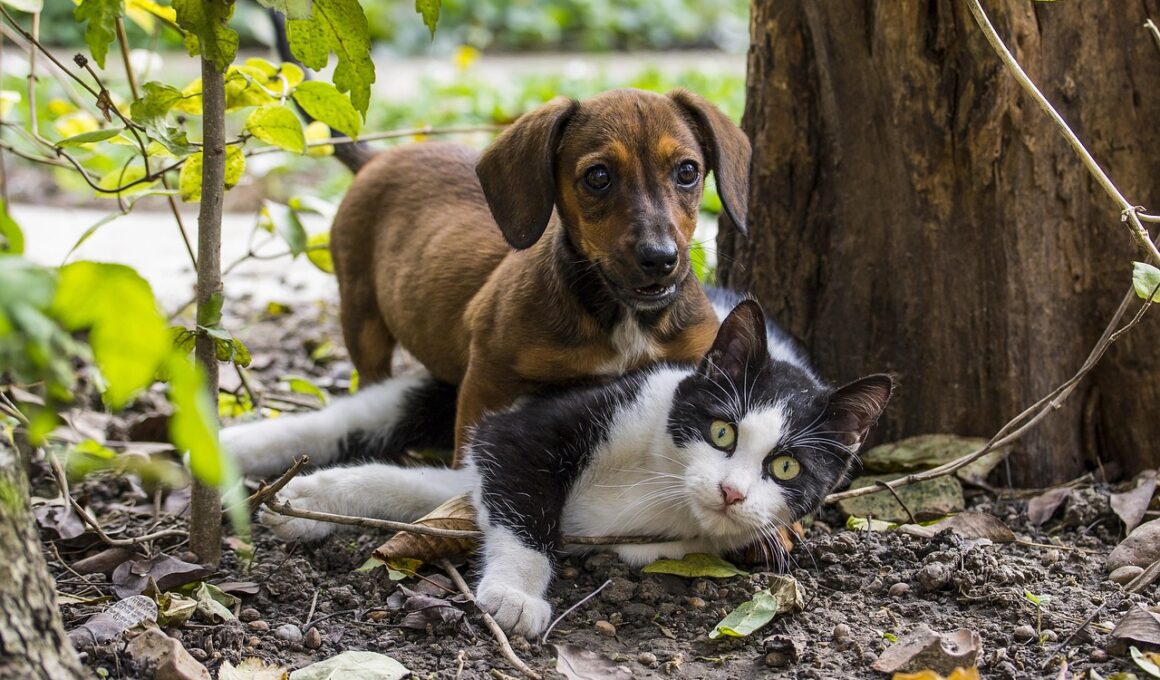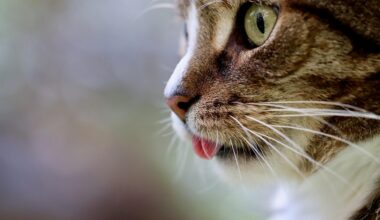Reactive Dogs and Cat Interactions: What You Need to Know
Understanding canine reactivity is essential for pet owners. Dogs may exhibit reactivity towards other animals, including cats. Such behavior often stems from fear, anxiety, or past negative experiences. When dogs react negatively, they might bark, lunge, or display aggressive postures. This can be distressing for their owners and those around them. Proper training and socialization can help in managing these issues. Identifying the triggers behind a dog’s reactivity is critical in this process. Sometimes, reactivity is a learned behavior from observing other dogs. The first step in addressing reactivity involves recognizing the signals your dog sends. Reactive dogs can learn to coexist peacefully with cats through gradual exposure. A controlled introduction is vital, starting from a distance where your dog feels secure. Implementing training techniques can foster positive associations. These techniques involve rewarding calm behavior when around cats. Patience is key, as it takes time to modify these behaviors. Always consult with a professional trainer to ensure a safe and effective approach. By being proactive, you can help your reactive dog become more comfortable in the presence of cats.
One common issue that arises during dog and cat interactions is territorial behavior. Dogs often protect their home environment, perceiving strange animals as a threat. This territoriality can lead to aggressive reactions, including barking or chasing. It’s important to manage these instincts carefully, as misdirected aggression can harm both cats and dogs. Introducing them in neutral territory can ease the tension. Always keep your dog on a leash during initial meetings. Gradually desensitize your dog to the presence of the cat while maintaining calmness. This process may take weeks or months, depending on your dog’s personality. You can utilize barriers, such as gates or crates, allowing them to safely observe each other. Gradual desensitization helps the dog and cat associate positive experiences with one another. Offer treats and praise as they become more comfortable. Keep sessions short to prevent overstimulation. If your dog continues to exhibit aggressive behavior, consult a veterinarian or trainer for further assistance. In cases of heightened anxiety or aggression, medication may be necessary. Each dog is unique, and understanding their individual needs can create harmony at home.
Teaching Calmness and Impulse Control
Another effective strategy is teaching your dog impulse control and calmness. Reactive behavior often escalates from excitement or anxiety, making it crucial to address these emotions. Training techniques that focus on self-control can significantly improve your dog’s interactions. Start with basic commands such as “sit,” “stay,” and “down.” Reinforce these commands with positive reinforcement approaches. Gradually introduce distractions, including the presence of the cat. When your dog successfully maintains composure, reward them generously. Incorporating regular training sessions can promote a stable routine, helping your dog feel more secure. Additionally, practicing controlled exposure to cats can benefit your dog’s behavioral training. Use low-stress environments initially, where the cat can observe without direct interaction. Over time, create opportunities for your dog to respond calmly around cats. The goal is to instill a sense of confidence in your dog. Building their confidence helps diminish anxiety about the cat’s presence. Consistent training fosters trust between you and your dog, allowing for a more manageable atmosphere. With time, patience, and proper training, reactivity can be significantly reduced.
For pet owners dealing with reactivity during dog-cat interactions, understanding body language is crucial. Canines communicate through various signals, and recognizing these cues enhances safety. If your dog displays signs of tension, such as raised hackles or a stiff tail, it’s essential to intervene before behavior escalates. Similarly, recognizing when a cat feels threatened is important as well, as they may hiss or swat. Observing both animals helps achieve a peaceful coexistence. Learning about canine and feline body language can prevent misunderstandings that lead to conflict. It empowers you to intervene at the right moment, reinforcing your dog’s calmness. Socializing your dog with well-behaved cats can also improve their behavior. Provide positive experiences to create a favorable association during their encounters. The sooner these associations are formed, the easier the process will become. Additionally, utilizing toys or treats during introductions can change negative experiences into positive ones. Always prioritize safety when allowing interactions. When in doubt, consult with a specialist for advice tailored to your animals’ specific needs. Observing and assessing all bodies’ behaviors can lead to successful interactions.
Seeking Help From Professionals
In instances where reactivity to cats remains unresolved, seeking professional help is advisable. Trainers or behaviorists specializing in canine reactivity can provide tailored strategies suited for individual dogs. They often analyze specific behavioral patterns and offer customized training programs. These professionals will observe both your dog and their interactions with the cat to pinpoint triggers and recommend interventions. Implementing systematic desensitization techniques has shown success in many cases. This gradual process exposes the dog to the cat under controlled conditions. With consistent training under expert guidance, significant improvements can generally be expected. Additionally, group training classes may help in socializing your reactive dog. Being exposed to various stimuli and learning alongside other dogs can reduce anxiety. Such environments often provide the needed distractions, allowing for essential learning moments. Attend classes that acknowledge both dog and cat interactions as a focus area. Furthermore, consider sharing information about your dog’s history with the professional. This enables them to devise a suitable framework that addresses both current issues and underlying causes. Collaborative efforts with professionals yield the best results for improving your dog’s reactivity.
Setting realistic expectations during the training process is vital for pet owners. The journey to reducing reactivity takes time, and progress may vary for each dog. Pet owners need to remain patient and consistent in their training efforts. Celebrate small victories and improvements, as every step counts. Acknowledging the significance of gradual progress helps in maintaining motivation. A reactive dog’s likelihood to change behavior increases with socialization. Offering opportunities to meet suitable dogs in controlled environments can foster positive experiences. Similarly, ensure that the cat receives its training and is comfortable around the dog. Working together as a household promotes a unified approach to handling behavioral issues. As your dog progresses in their training, the overall environmental stress decreases. This creates a harmonious atmosphere for both cats and dogs. Regular enrichment activities can further contribute to reducing reactivity. Engaging activities help stimulate the dog mentally and physically. Providing robust daily routines can counterbalance potential energetic outbursts. Remember, seeking support and community resources can be invaluable throughout the process. Joining support groups or online forums allows shared experiences and advice among pet owners, aiding everyone in their journey.
Conclusion: Creating Harmony at Home
Ultimately, addressing canine reactivity towards cats is about creating harmony at home. Ensure you understand your dog’s behavior, needs, and emotions through training and consistent interactions. Together, these aspects help alleviate reactivity and create a safe environment for pets. Take time to invest in building a solid bond with your dog, allowing mutual respect and understanding. Ensure that both dogs and cats receive individual attention, fostering a well-balanced household dynamic. Gradually introduce both pets to one another under supervision, allowing positive experiences to form over time. Proper management, through training and conditioning, enables better reactions. Regular training sessions ensure you stay on track. As pets become accustomed to each other, interactions should become more relaxed. Don’t shy away from employing professional help when necessary. Knowledgeable trainers can provide the guidance required to foster a peaceful coexistence. Remaining patient, dedicated, and knowledgeable is the key to success. By creating a structure that supports calming behaviors, you enhance both cats’ and dogs’ comfort levels. Focus on progress rather than perfection, and success is achievable. With time, pets that once struggled can develop healthy relationships.
The Importance of Training and Socialization
Having a proactive approach toward canine reactivity is immensely beneficial in fostering better interactions. Training and proper socialization play critical roles in helping dogs learn how to behave around cats. This process involves exposing the dog to various environments, stimuli, and other animals in a controlled setting. Through positive reinforcement and consistent training, dogs can develop better impulse control around cats. Training sessions should be fun as well as educational, combining exercises that teach calm behaviors and commands. Ensure the dog feels secure and comfortable while interacting with cats. Gradually increasing exposure to the cat is essential. Begin with short sessions and gradually expand to longer interactions as comfort levels rise. Observe your dog while maintaining patience and a calm demeanor. If issues arise, take a step back to reassess and modify approach to training, ensuring it remains positive and engaging for the dog. While reactivity can be challenging, a tailored program with clear objectives can effectively change behaviors for the better. Regular practice and familiarization with the circumstances also yield gradual progress. Preparing both the dog and the cat for each encounter contributes to long-term success.


